Abstract
Urban-rural development and transformation is profoundly changing the socioeconomic system as well as the natural environment. The study uses the AHP (Analytic Hierarchy Process) method to construct a top-down index of human activity based around five dimensions (population, land, industry, society, and environment) to evaluate the spatial characteristics in the region east of the Hu Huanyong line, China, in 1994 and 2010. Then, we investigate the spatial-temporal pattern using the methods of hotspot analysis, local Moran’s I index and Pearson correlation coefficient. The calculation showed that: (1) northeast China was experiencing an economic recession during study period, and the implementation of revitalization plan have not controlled the recession trend yet; (2) Pearson correlation analysis showed that the improvement of population quality promote the development of industry and society systems significantly during study period; and (3) negative correlation between Population Development Index (PDI) change and Population Transformation Index (PTI) change (along with the Society Transformation Index (STI) change and Industry Transformation Index (ITI) change) reflected that east of the Hu Huanyong line, China was in a “demographic dividend” period. Then, with the help of SOFM neural network algorithm, we divided the study area into six types of region, and found that municipalities, provincial capitals, Yangtze River Delta region and cities on the North China Plain owned the greatest development, while cities in southwest and northeast China showed relatively poor development during study period.
1. Introduction
The urban-rural development and transformation process comprehensively includes the process of production factor transformation, man-earth relationship transformation and institution/mechanism conversion in a country’s modernization process. In China, urban-rural development and transformation mainly relies on industrialization, informatization, urbanization, and agricultural modernization. These four processes have significantly enhanced the country’s social-economic level and improved the residents’ standards of living. However, rapid urban-rural transformation has also caused a number of environmental problems, including the aggravation of human-induced natural disasters, such as heat waves, floods and toxic haze [1,2]. Indeed, over the past 50 years, ecosystems have changed more rapidly and extensively than in any other comparable period in human history [3]. Therefore, in order to prevent the imbalance in human-land relationship and achieve sustainable development, it is essential to first understand the process of urban-rural development and transformation.
Current academic research on urban-rural development and transformation contains the following aspects: (1) the investigation on population migration [4,5,6]; (2) the spatial structure change [7,8]; (3) industrial transformation and adjustment from an industrial geographical perspective [9,10,11]; and (4) policy and institutional changes [12,13,14,15]. Some scholars focused on the process of rural transformation development [16,17,18,19,20,21,22]. Land use change is an important issue to urban-rural development and transformation process; as such, many attempts have been made to model the process and analyze its influence to the social economic change [23,24,25,26]. Others focused on the characteristics of urban-rural transformation [27,28,29,30] and examined its influence on ecological and environmental change [31,32,33,34,35,36]. Nevertheless, such single factor analysis always ignores the broader perspective. Realizing the advantage of using the “top-down” approach, many scholars have applied it to regional studies [37,38]. Even so, most existing studies are limited to one specific time point, ignoring the dynamics of spatial-temporal processes.
In order to bridge this gap in the literature and contribute to the body of urban-rural development and transformation research, this study constructs two top-down indexes, the urban-rural development index (DI) and the urban-rural transformation index (TI), to quantify the modernization process in China. The concept of development in economics means a chronically stagnant country can maintain 5%–7% GDP growth rates per year during its development process [39]. We build the development index to describe the quantitative changes in the social and economic system. Correspondingly, the concept of transformation refers to the changes in structure, form and operation mode, human geographers use it to describe regional evolution from low-level steady status to high-level steady status. Therefore, we design the transformation index to depict the qualitative changes in all aspects of social economic system.
The two indexes are drawn from five dimensions, namely the population, land, industry, society and environment dimensions. The traffic dimension is also important to describe urban-rural transformation process; however, it is not included because of missing data. In the Results and Discussions, we calculate the development index (DI) and transformation index (TI) of the study area in 1994 and 2010, including changes during the 16 years to detect the characteristics of Development Index change and Transformation Index change. Then, we classify the study area into six districts and discuss the meaning of this research. In the Conclusion Section, the paper summarizes the conclusions obtained in the above section.
2. Methodology
The research consists of four distinct stages. The first of these is constructing the urban-rural development index and urban-rural transformation index (termed simply development index (DI) and transformation index (TI)) using the AHP (Analytic Hierarchy Process) method. The second includes detecting hot spots and cold spots of study area using the hotspot analysis tool in ArcGIS; followed by detection of correlations between DI and TI via Pearson correlation coefficient method and Bivariate Local Moran’s I method. In the last stage, we use the self-organization feature map (SOFM) neural network algorithm to zone the study area into different region types.
2.1. AHP Method and Index System Building
The Analytic Hierarchy Process (AHP) method is a multi-criteria decision making method in which factors are arranged in hierarchic structure [40]. It involves qualitative and quantitative analysis approaches, and it has been widely used in the field of human geography [31]. In this study, we use the AHP method to build DI and TI for the purpose of evaluating urban-rural development and transformation patterns in 1994 and 2010. Both DI and TI are composed of five dimensions: population, land, industry, society, and environment. The indexes and corresponding abbreviations are in Table 1. The principals for indicator selection are their scientific, integrity and maneuverability characteristics [41].

Table 1.
Constitution of urban-rural development and transformation indexes.
DI is composed of 11 socioeconomic indicators, most of which are to reflect quantitative changes in urban-rural areas. For example, we choose the total population and natural population growth rate to represent population quantity change, and we assume that in general society, the educational level and medical condition is gradually increasing along with the expansion of population and land area. Thus, we choose college students per 10,000 people and number of beds in health institutions to reflect the society dimension.
TI consists of 11 socioeconomic indicators as well, most of which reflect the qualitative changes of urban-rural areas during the study period. Take population dimension as an example, labor force proportion and population aging degree reflect the age structure of population, non-agricultural population proportion reflects the employment structure, and average education level reflects the knowledge level of population; thus, these four indicators comprehensively represent the quality of population. It is necessary to mention that domestic sewage treatment rate could not entirely reflect the environmental quality improvement. However, the domestic sewage treatment is the only indicator that we could obtain to represent the environment dimension considering the availability and maneuverability of the dataset. We confirm the weight of each indicator through Delphi method. We sent the weight system to influential experts in geographical research field, and fully considered their opinions. The concrete evaluation index system is shown in Table 1. The direction represents the correlation type of each indicator: “+” means the indicator is positively correlated with DI/TI, while “−” means the indicator is negatively correlated with DI/TI.
The computation equations for DI/TI are as follows:
2.2. Hotspot Analysis Method
The Hot Spot Analysis tool is a functional module of ArcGIS software. It calculates the Getis-Ord Gi* statistic for features in the dataset. By means of calculation, we can tell where features with either high or low values cluster spatially. Hot spots are places where high value features gather, while cold spots are the opposite places.
The formula of Getis-Ord Gi* is as follows [42]:
where are elements of contiguity matrix for distance d. The matrix assigns a spatial weight for each point pair within a distance d of i. The resultant Gi statistic is in the form of z-scores and p-values [42]. In this study, we use hotspot analysis method to search for high and low value clusters of DI and TI, with the purpose of understanding the spatial and temporal change in features during study period.
2.3. Pearson Correlation Coefficient and Local Moran’s I Methods
We applied Pearson correlation coefficient method to measure linear relationships between two datasets: the higher the Pearson coefficient is, the stronger the correlation would be. The Local Moran’s I method can reflect the significance level of indicators on spatial association. In this research, we use Pearson correlation coefficient and Bivariate Local Moran’s I methods to analyze correlation between DI and TI. The computational formula of Pearson correlation coefficient for two variables, X and Y, is as follows:
where , . The coefficient ranges from −1 to 1.
The computational formula of Local Moran’s I index is as follows:
where , .
The standard test value Z is as follows:
2.4. Self-Organization Feature Map Neural Network Method
The Finnish scholar Kohonen [43] first proposed the self-organization feature map neural network (SOFM for short). It is a competitive learning network, which can learn self-organized training without supervision. The SOFM is composed of input layer and competition layer. The competition layer is composed of a two-dimensional planar array. The nodes in the input layer connect with the nodes in competition layer by variable weights. The ultimate principle of SOFM neural network is that the nodes in the competition layer provide content for the response chance of the input mode [44]. Only one node will win, and this node represents the result of classification. In this study, based on the evaluation results for the three years, we classify the study area into six regions using self-organization feature map neural network method in MATLAB platform.
3. Data Source and Study Area
3.1. Data Source
The data source in this study is the China City Statistical Yearbooks 1995 and 2011 [45,46]. Population data comes from the Population Censuses of the People’s Republic of China [47,48].
3.2. Study Area
The study area is the region east of the Hu Huanyong line (also known as the Aihui–Tengchong line) in China. The Chinese geographer Hu Huanyong first discovered this line in 1935 during the research on Chinese population density. The region east of the line occupies 36 percent of China’s land area, while containing nearly 96 percent of the total population. The major geographical structure is plains, hills, water networks, and Danxia landform, and the major production mode is farming. The geographical features east of the Hu Huanyong line contrast with those in northwest, China (Figure 1).
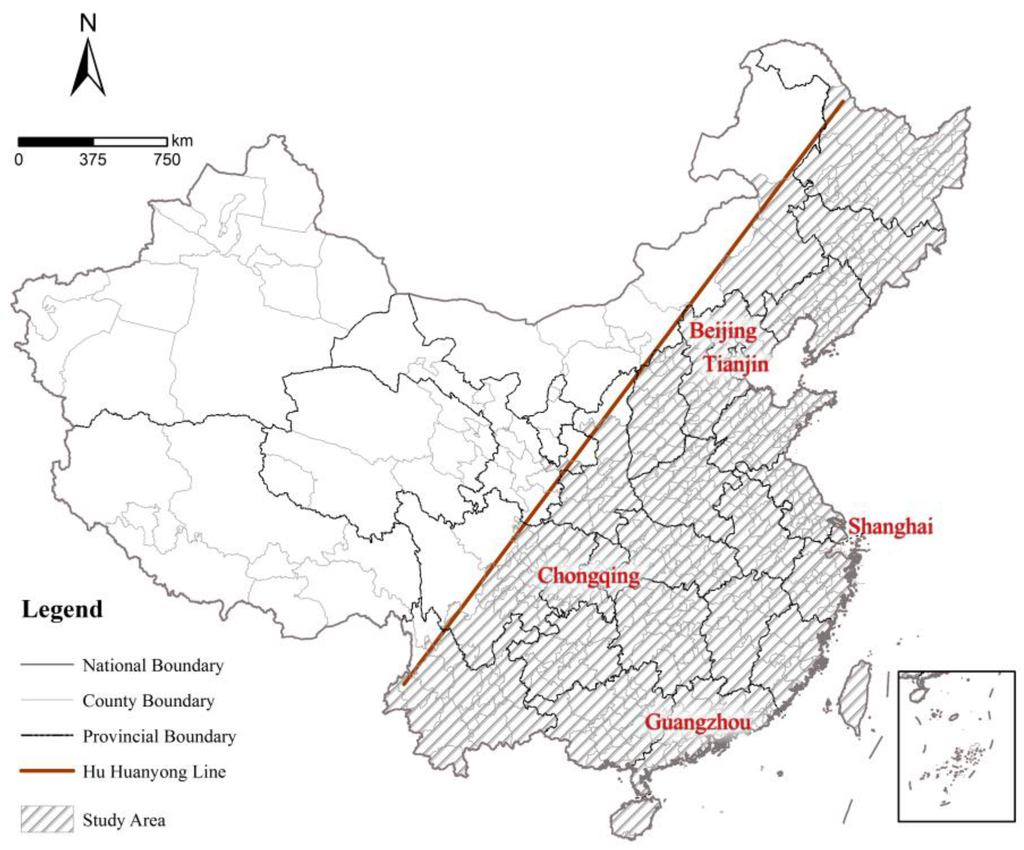
Figure 1.
Location of study area.
4. Results and Discussions
4.1. Spatial Patterns of the DI and TI
Based on AHP method, we calculate the urban-rural development index (DI) of study area in 1994 and 2010, and then we classify the area into four types of regions, the low value (0–0.04), relatively low value (0.04–0.12), relatively high value (0.12–0.2) and high value (0.2–0.64) regions, in ArcGIS. The result of DI patterns in two years is as follows (Figure 2).
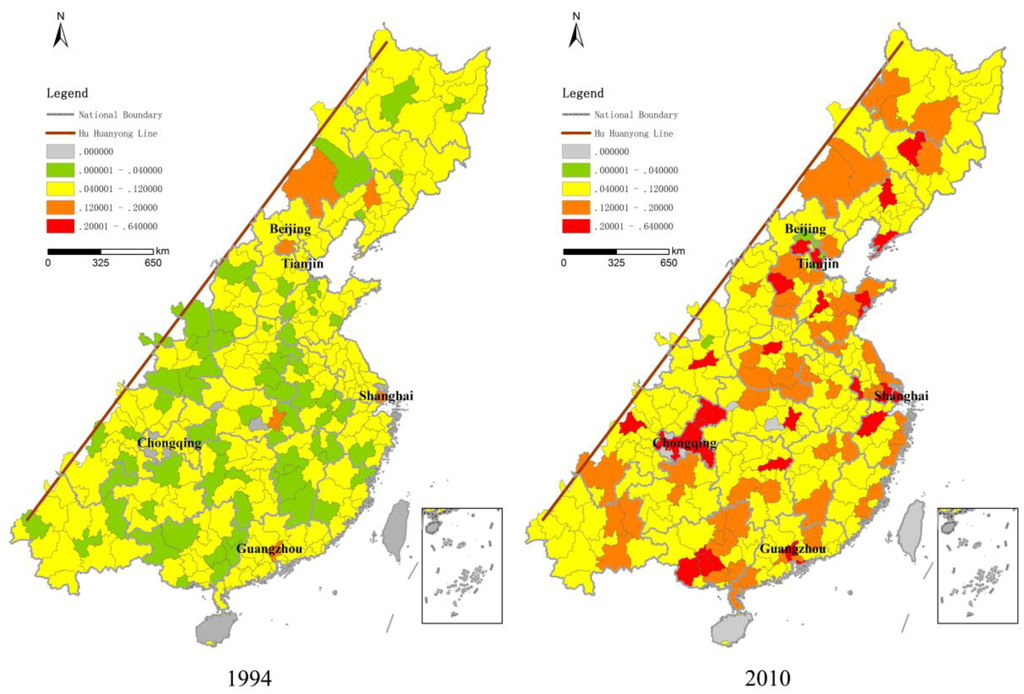
Figure 2.
The spatial distribution pattern of Development Index in 1994 and 2010.
In 1994, the municipalities of Beijing, Tianjin, Shanghai and Chongqing; provincial capitals such as Guangzhou and Wuhan; and big cities in northeast China such as Heihe and Chifeng had a relative high DI values. Jiangxi, east Henan, Guangxi and south Shanxi Provinces had a relatively low DI values.
In 2010, the DI in the study area experienced a significant increase. The high value of DI was still located in the municipalities of Beijing, Shanghai, and Chongqing and provincial capitals such as Guangzhou, Shenzhen, Zhengzhou and Nanjing. Cities in northeast China, west Fujian, Anhui Province, southwest China and regions along the Hu Huanyong line received low values. The accumulation of high DI areas in Bohai Rim Region, Yangtze River Delta Region and Pearl River Delta Region became more and more significant.
In order to investigate the dominant factors for the spatial distribution pattern of DI, we chose the individual development indexes (PDI, LDI, IDI, SDI and EDI) in 2010 to detect the high value and low value regions based on the hotspot analysis module in ArcGIS. We found that the hot spot areas of DI were mainly located in the cities of Bohai Rim Region and Yangtze River Delta Region (Figure 3).
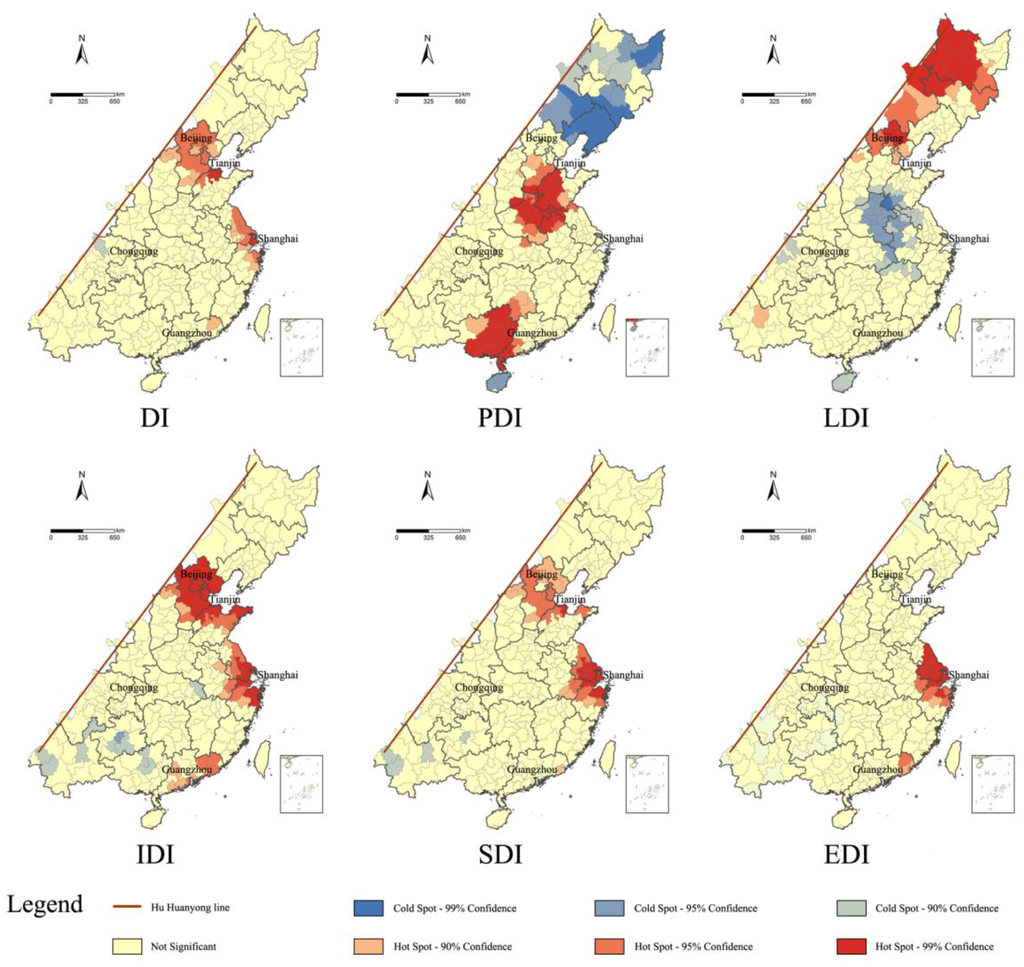
Figure 3.
The hotspots analysis of DI and individual DIs in 2010.
Among the five individual DIs, the population DI (PDI) showed that Henan, north Anhui, Guangxi, and Shandong Provinces were in high value clusters. Through observation of data sources, we realized that the huge amount of total population drove the high DIs of Henan and Shandong Provinces, while that in Guangxi Province derived from its rapid population growth. The cold spots of the population index were around northeast China owing to the small population size and, more importantly, low rate of population growth. The land DI (LDI) results showed that northeast China and municipalities such as Beijing and Tianjin were in the high value range because of large land areas and the expansion of built-up areas, respectively. The cold spots of the land DIs were around central China, such as Henan, Shandong and Anhui Provinces, mostly because of their small average areas and limited built-up area growth rates.
The industry DI (IDI) in the Bohai Rim, Yangtze River Delta, and Pearl River Delta regions had high values. It is worth noting that these regions also owned the fastest economic growth rates in China as well as the highest degree of human capital accumulation and creative power. The cold spots were around southwest China such as Yunnan and Guizhou Provinces, which are economically backward areas.
The distribution of society DI (SDI) was similar to that of industry DI: the hot spots were mainly located in the Bohai Rim and Yangtze River Delta regions such as Hebei, Jiangsu, Zhejiang, and Shandong Provinces, while the cold spots were around southwest China. Such similar distribution possibly owns to the fact that industrialization and economic growth will significantly promote the development of society.
The environment DI (DI) in 2010 for the cities in Yangtze River Delta Region of China were relatively high. These regions also showed high economic development and social welfare. The assumption is that a city with higher socioeconomic development would prefer to pay more money to improve its environment and living conditions.
Using the Pearson correlation coefficient method, we tested the relationship between different DIs in 2010 (Table 2). The highest correlation was between the industry DI and society DI, with the coefficient reaching 0.849, indicating high connection between industrialization and social development; the correlation between the society DI and environment DI was relatively high (0.740), so was the industry DI and environment DI (0.718). The lowest correlation was between the population DI and environment DI. The high correlation between IDI and SDI/IDI indicated that, along with the advance of regional GDP and non-agricultural products, the government revenue increased correspondingly. As a result, the government paid more money to raise the level of regional public services, improve the living standard of local residents and increase the green land area with the purpose of improving those regional environments.

Table 2.
Pearson correlation analysis results of different development indexes in 2010.
Based on the calculation of TI (urban-rural transformation index), we classified the area into four types of regions as well, the low value (0–0.4), relatively low value (0.4–0.6), relatively high value (0.6–0.7) and high value (0.7–1) regions in ArcGIS. The result of the TI is shown in Figure 4. The figure shows that in 1994, the municipalities of Beijing, Tianjin, Shanghai and big cities like Shenzhen had high TI values. Chongqing, provincial capitals including Guangzhou, Hangzhou, and Kunming and cities in the northeast China had relative high TI values. On the contrary, the cities in southwest China, west Shandong and east Henan had low TI values.
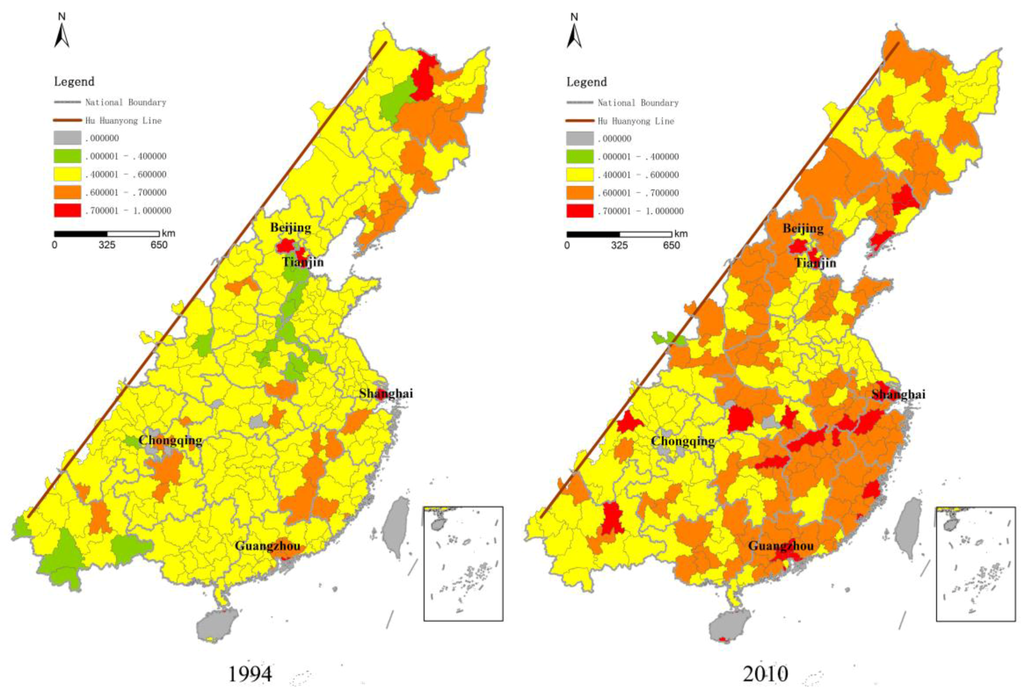
Figure 4.
The spatial distribution pattern of Transformation Index in 1994 and 2010.
The results of 2010 showed that the overall TI east of the Hu Huanyong line increased significantly. The values in the municipalities such as Beijing, Tianjin and Shanghai, provincial capitals and big cities in the study area increased significantly, while cities in southwest China and northeast China were mostly in low value range, especially in Yunnan and Heilongjiang Provinces. In addition, the further increases in the TIs in the Yangtze River Delta and Pearl River Delta regions along the east coast of China were a significant feature in this period.
The hotspot analysis result for the TI in 2010 showed that the high value cluster was in southeast China including Zhejiang, Fujian, Jiangxi Provinces, and north China including Hebei, Beijing and Liaoning Province (Figure 5). Correspondingly, the low value cluster was in southwest China including Guizhou, Sichuan and southwest Hubei. Population TI showed that northeast China was in a high value cluster region, while low value areas were mainly located in southwest China, indicating a higher population quality in the northeast and a lower population quality in the west. South China including Yunnan and Sichuan Provinces had high land TIs, while central and east China such as Henan, Jiangsu, Shandong, and Zhejiang Provinces had low values. These regions are major grain producing areas, with a higher percentage of cultivated land. The hot spots of the industry TI were in Shandong, Shanxi, Anhui, Zhejiang, Jiangsu, and Guangdong Provinces, mostly in the Pearl River Delta region and Yangtze River Delta region, while the cold spots were in west China and northeast China such as Yunnan, Heilongjiang, and Guizhou Provinces. The society TI showed that Yangtze River Delta region, Bohai Rim region, and Pearl River Delta region were the three highest value clusters in study area, while the cold spots were in western regions such as Yunnan and Shaanxi Provinces. The distribution of environment TI showed a high value cluster in central and east China, containing Huang-Huai-Hai Plain and Beijing-Tianjin-Hebei region. These areas also had the most serious environmental problems, including toxic haze and water pollution.
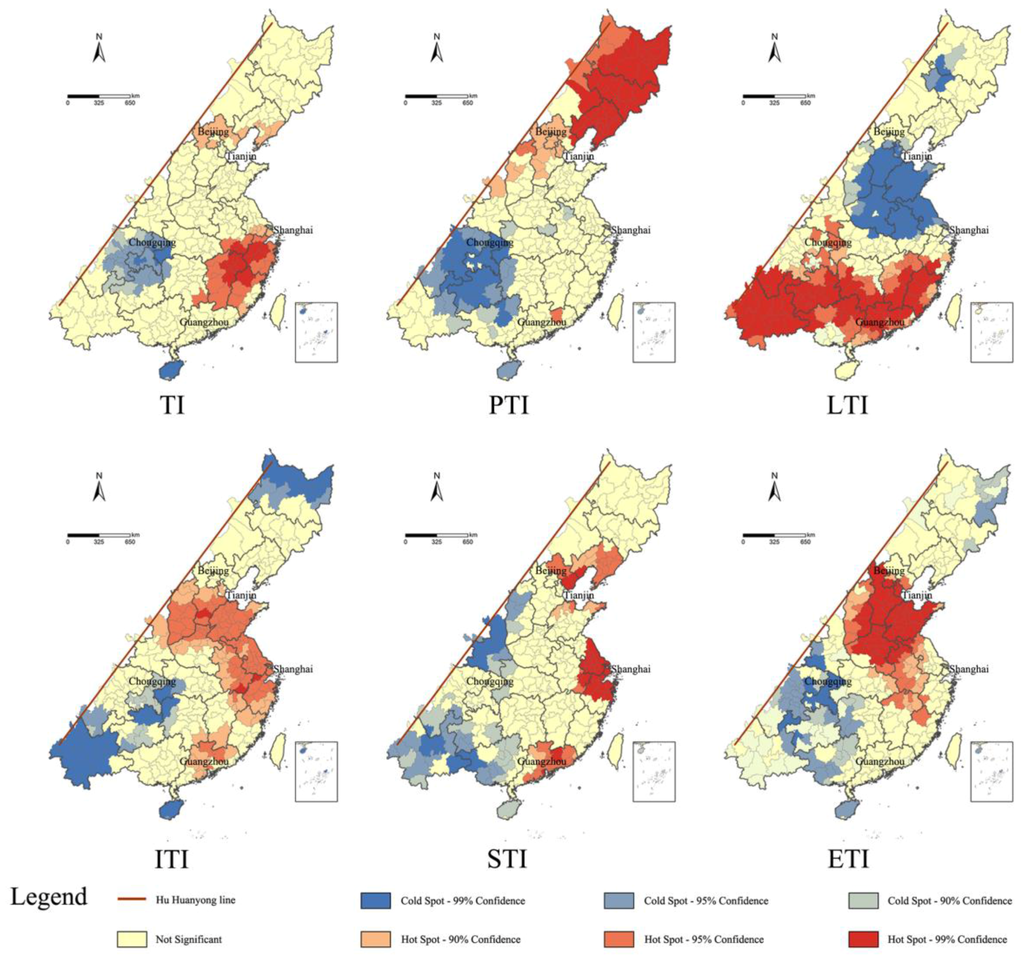
Figure 5.
The hotspots analysis of TI and individual TIs in 2010.
Relying on the calculation results of TI, we tested the correlation between different individual TIs (Table 3). The Pearson correlation coefficient test showed the highest positive correlation between the population TI and society TI, with the coefficient reaching 0.527, indicating a potential high connection between population quality and social economic development. The correlation coefficient between population TI and industry TI was also high (0.526). The high correlation between PTI and ITI/STI reflected the fact that the optimization of population structure would play a great role in upgrading the regional level of social economic development. According to Table 2, PTI comprehensively reflected the age structure, employment structure and educational structure of the population. The upgrading and improvement of non-agricultural industry would create more employment opportunities for the labor force, which would attract more young adults with good educational background to cities. Thus, the comprehensive quality of local population would improve, and the industry system and society system would experience a new round of rapid development.

Table 3.
Pearson correlation analysis results of different transformation indexes in 2010.
In the next step, we explored the correlation between the DIs and TIs. Using the Bivariate Local Moran’s I index method, we characterized the correlation types for two indexes in 1994 and 2010. The results showed that the “high-high” correlation type was mostly located in Zhejiang, Jiangxi and Jiangsu Provinces, indicating a significant development advantage in society and economy compared with other regions. By contrast, the “low-low” correlation type was mostly located in Henan, Anhui, and Sichuan Provinces, implying that the development and transformation processes in these regions were relatively slow, High-Low and Low-High types represent regions with unsynchronized development and transformation speeds (i.e., the development rate is higher than the transformation rate).
4.2. Spatio-Temporal Characteristics of Changes in the DI and TI Over Time
Based on the per-period analysis presented above, we then explored the spatio-temporal changes in each index for the 16-year study period. Figure 6 shows the result for the change in DIs, with red representing the fastest-growing areas and green the slowest-growing areas (note that, owing to the lack of sewage treatment rate data in 1994, we used the data in 2002 instead).
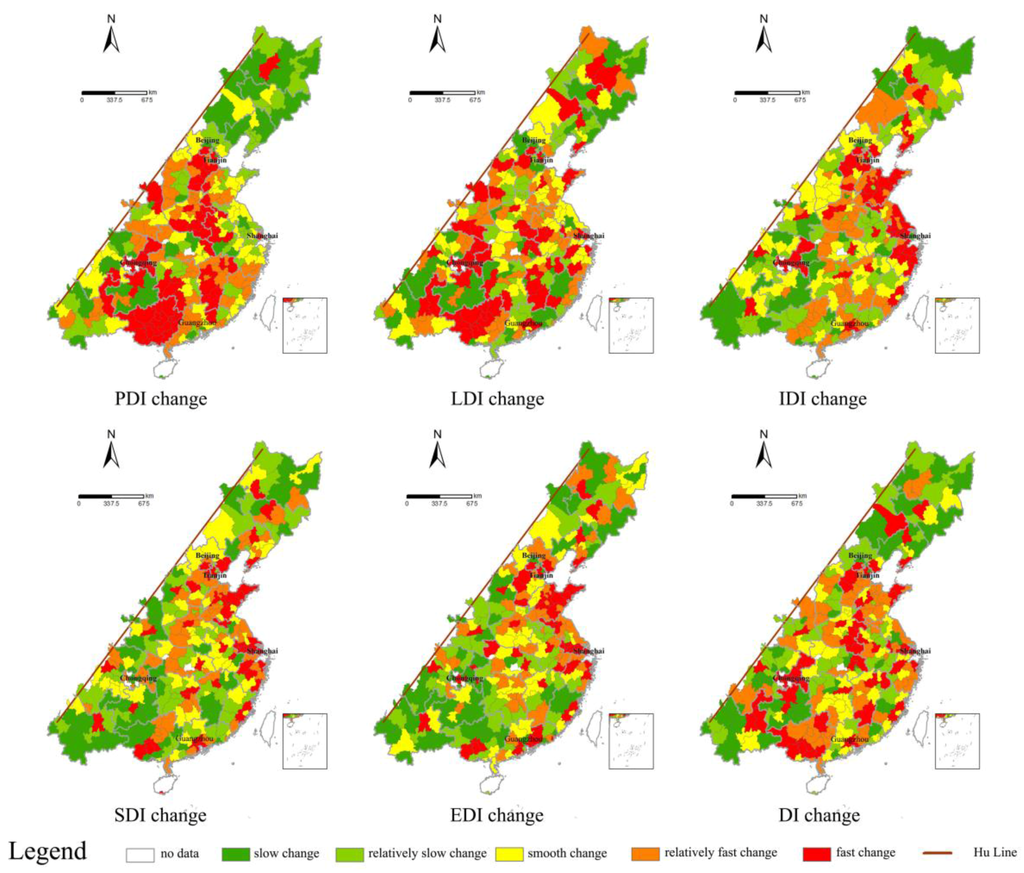
Figure 6.
DIs change between 1994 and 2010.
The fastest-growing areas of the population DI were mainly located in southwest China (Guangxi and Chongqing) and central China (Henan and south Hebei). By contrast, the slowest-growing areas of the population DI were in northeast China. The fastest-growing areas of the land DI were in municipalities including Chongqing and Shanghai; provincial capitals such as Guangzhou and Changchun; and provinces including Guangxi, south Jiangxi and east Hubei, whereas the slowest-growing areas were in northeast and southwest China such as Yunnan and Sichuan Provinces. The fastest-growing areas of the industry DIs were in four types of regions, the municipalities, the provincial capitals, three growth poles in China (the Yangtze River Delta region, Bohai Rim region, and Pearl River Delta region) and big cities in east coast China, while the slowest-growing areas were north of Heilongjiang Province and west of Yunnan and Guizhou Provinces. The fastest-growing areas for both the society DI and the environment DI were in the three growth pole regions and provincial capitals of China, whereas the slowest-growing areas were in southeast China including Yunnan, Guizhou, and Guangxi Provinces. In summary, the DIs showed a fast increase in the three growth pole regions as well as in provincial capitals, south Guangxi, south Jiangxi, east Hubei and east Henan provinces, but a slow increase in the northeast and west of the country.
The result of TI change during the 16 years showed that the population TI increased the fastest on the east coast, south Yunnan, south Sichuan, and Shanxi Province, while the slowest regions were in east and southwest China such as Guangxi, Guizhou, Sichuan, and south Jiangxi Province (Figure 7). The land TI increased the fastest in west China along the Hu Huanyong line and slowest in the northeast China. The industry TI increased the fastest in Sichuan Province along the Hu Huanyong line as well as in Yunnan Province, south and west Shandong, east and south Hunan Province, north Guangdong and south Zhejiang Province, most of which are located in relatively undeveloped regions, whereas the slowest change occurred in northeast China, the abovementioned four municipalities, east Henan and south Jiangxi Province. The society TI showed that the four municipalities, most provincial capitals, the Yangtze River Delta and Pearl River Delta regions, and east Guizhou Province were the fastest transformation areas, whereas regions in west China along Hu line were the slowest. Finally, the environment TI showed that the four municipalities, central China including Henan, Jiangxi and Anhui Provinces, and Heilongjiang Province owned the fastest variation rates, while the major cities in west China owned the slowest. In summary, in some of the regions, the speed of environment TI variation showed a positive correlation with the industry TI change, both because the treatment rate of domestic sewage was limited by pollution control technology and because of the pollution control cost. The cities with faster land use transition and stronger economies were more likely to import advanced technology and incur higher costs to solve the pollution problem.
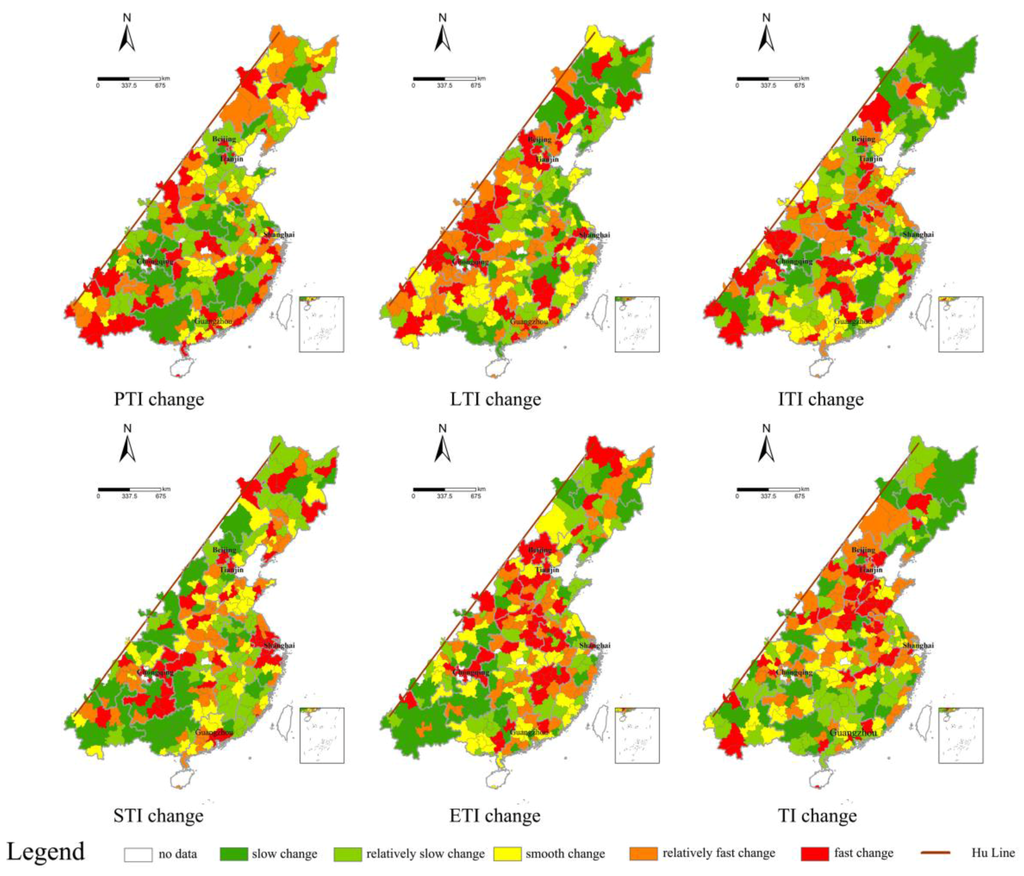
Figure 7.
TIs change between 1994 and 2010.
Besides, we also found that northeast China (including Heilongjiang, Jilin, Liaoning and east Inner Mongolia) was experiencing an economic recession during study period. The absolute value of DI in northeast China increased while the relative value of DI decreased during the 16 years. In the year 2010, the DI of northeast China fell behind all other regions east of the Hu Huanyong line. Correspondingly, the relative value of TI in northeast China also decreased significantly, representing the fact that both the quality and quantity of development in northeast China were in decline. The possible explanation was that the implementation of the priority development strategy for heavy industry had led northeast China to become an economically developed region in China before the 1990s. However, along with thoroughly carrying out reform and the opening-up policy, the northeast gradually fell behind the southeast coast of China and slipped into economic recession. Although the central government had implemented the revitalization strategy for the old industrial base in northeast China in 2003, the recession trend has continued according to our research.
We used scatter plots of DIs and TIs to analyze the correlation between the two groups of variables. The result showed that in 2010 the DI and TI was in positive correlation, with an R value of 0.42, reflecting that along with the increase of population quantity, economic quantity, built-up areas and social consumption quantity, the comprehensive quality of population, industrialization level and urbanization level improved synchronously, as well as the environmental governance enhancement. Among all the index change plots, SDI change showed positive correlation with STI change, with an R-value of 0.47. PDI change showed negative correlation with PTI change, with an R-value of 0.39, representing the opposite variation trend between population scale and population quality. Take Guangxi and Jilin Provinces as an example, during the study period, the PDI of Guangxi increased faster than other provinces, while the PTI increased relatively slowly. Jilin was had the opposite experience, with a slower PDI change and a faster PTI change. The possible explanation for such phenomenon was that China experienced a “demographic dividend” during the study period. The decline of fertility rates and population quantity would significantly promote social economic development process, which would improve the age structure, educational structure and employment structure of population, according to previous research (the PTI showed high correlation with ITI and STI), thus, leading to an unsynchronized variation trend between PDI change and PTI change (Figure 8). Other indexes did not show significant correlations.
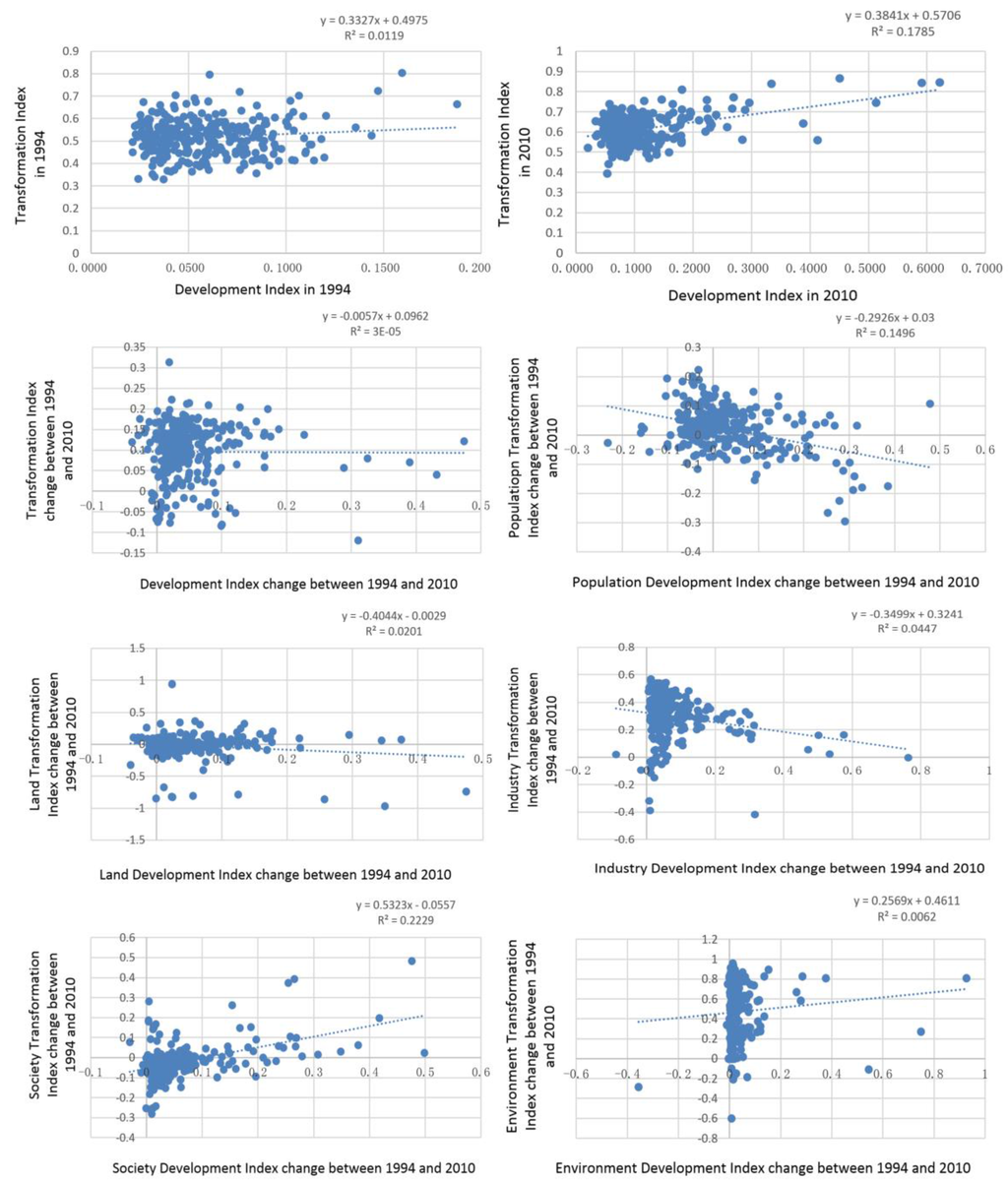
Figure 8.
The scatter plots of DIs (change) and TIs (change) between 1994 and 2010.
4.3. Spatio-Temporal Patterns of the DIs and TIs by Region
Based on the analysis of the spatio-temporal patterns derived from the DIs and TIs as well as their change over time, we divided the study area into six regions termed A to F based on Self-organization Mapping (SOM) Neural Network using the software platforms ArcGIS and MATLAB (Figure 9). The distributions of the cities and their transformation characteristics are shown in Figure 9 and Figure 10.
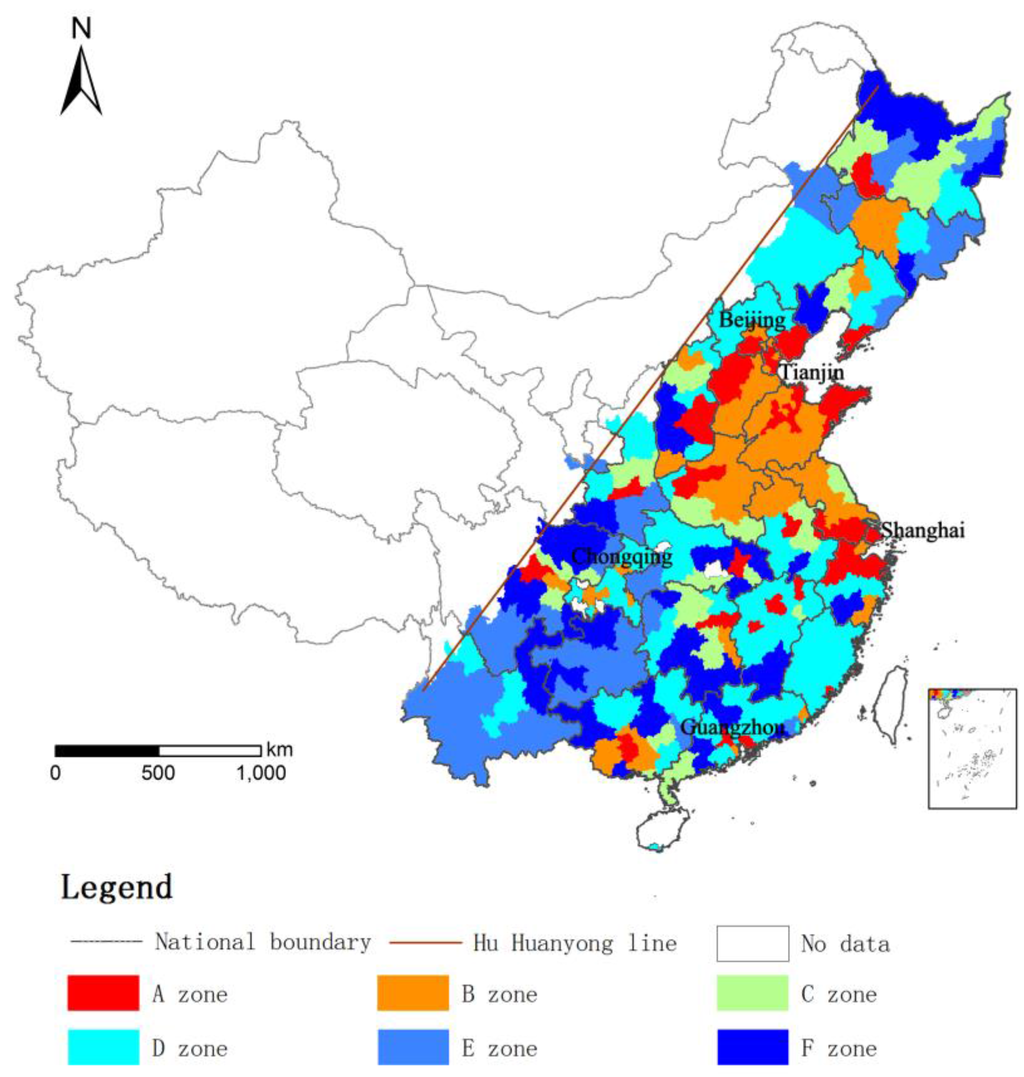
Figure 9.
Urban-rural development transformation type division in east of the Hu Huanyong line in China.
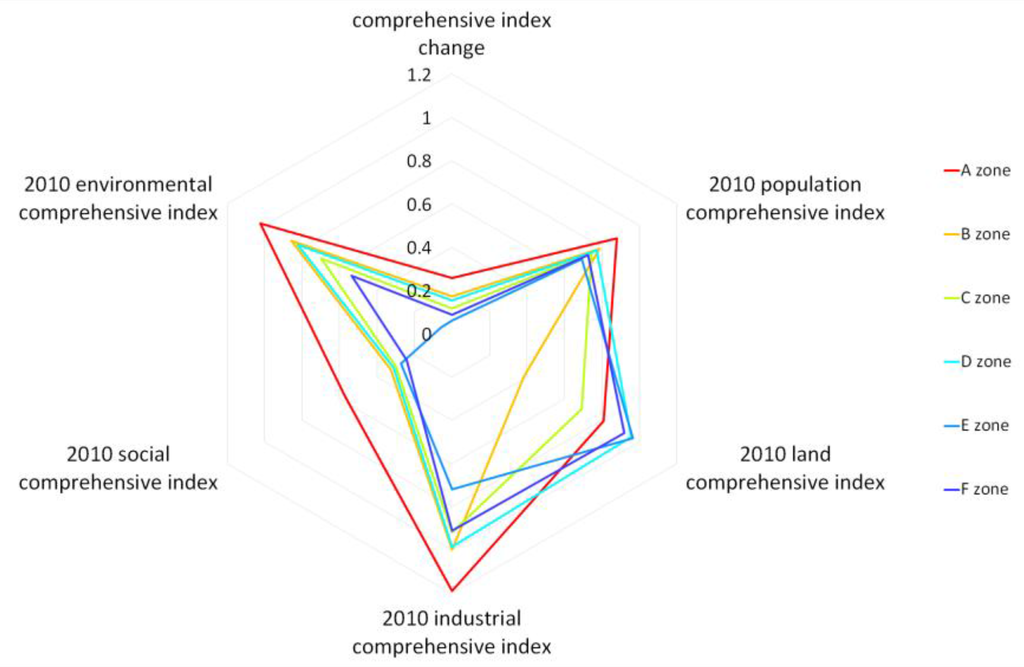
Figure 10.
The single and comprehensive indexes of each type.
Region A, which comprised the municipalities of Beijing, Tianjin and Shanghai, most of the provincial capitals, south Jiangsu, and east Shandong Province, the socioeconomic development and transformation levels were the highest. During the 16-year study period, the average DIs and TIs increased the fastest, indicating rapid socioeconomic development in this region. Thus, we named the A region “multi-factor driven rapid development and transformation region”. Region B, which contained the second most cities, mostly distributed in the Huang-Huai-Hai Plain including Hebei, Shandong, Henan, Anhui, and Jiangsu Provinces as well as south Guangxi Province and northeast China. It was close to Region A in terms of space, and its increase in DIs and TIs over time was relatively fast. We named this region “industry and population driven rapid development and transformation region”. Region C mainly comprised the middle and west of Heilongjiang, middle Shaanxi, south Henan, north Shanxi, east Jiangsu, east Anhui, east Hunan and south Guangzhou Provinces, showing a steady development and transformation level, with its overall DIs and TIs increasing smoothly. We named this region “multi-factor driven smooth development and transformation region”. Region D contained the most cities, mainly distributed in Inner Mongolia along the Hu Huanyong line, northeast China (e.g., north Liaoning and north Heilongjiang), east China (e.g., north Jiangxi, Fujian, east Guangzhou, Guangxi, and central Hubei), and southwest China (e.g., Chongqing). Here, the development and transformation levels were relatively high. We named it “smooth development and transformation region driven by industrialization and land use transition”. Region E mainly located in southwest China (including Yunnan, Guizhou and Sichuan Provinces) and northeast China including cities in Heilongjiang and Jilin Provinces, which are relatively backward economic development areas. We named it “slow development and transformation region”. Region F (e.g., north and east Heilongjiang, west Liaoning, west Shanxi, south Hunan, south Jiangxi, and west China) showed lagging development and transformation levels, with a slower overall index change over time, representing relatively low socioeconomic development. We named it “industry and land driven slow development and transformation region”.
5. Conclusions
In this study, we built two indexes based on five dimensions (population, land, industry, society and environment) to quantify the process of urban-rural development and transformation in east of the Hu Huanyong line in China from 1994 to 2010. Relying on the calculation results, we drew the following conclusions: (1) northeast China was experiencing an economic recession during study period, and the implementation of revitalization plans had not controlled the recession trend yet; (2) Pearson correlation analysis showed that improvement of population quality promoted the development of industry and society systems significantly during study period; (3) negative correlation between PDI change and PTI change (along with STI change and ITI change) reflected that China east of the Hu Huanyong line was in a “demographic dividend” period; and (4) type division showed that municipalities, provincial capitals, Yangtze River Delta region and cities on the North China Plain owned the greatest development, while cities in southwest and northeast China showed relatively poor development.
Acknowledgments
The National Natural Science Foundations of China (No. 41330747, 41130748) financially supported this research. Great thanks to Yurui Li in the Institute of Geographic Sciences and Natural Resources Research, Chinese Academy of Sciences, and other individuals and communities in Peking University and Chinese Academy of Sciences without whose help this research would not have been possible.
Author Contributions
Yansui Liu, Hualou Long and Zhichao Hu conceived and designed the experiments; Yanglin Wang and Zhichao Hu performed the experiments; Jian Peng and Zhichao Hu analyzed the data; Yanglin Wang and Jian Peng contributed to analysis tools; Zhichao Hu wrote the paper.
Conflicts of Interest
The authors declare no conflict of interest.
References
- United Nations Development Programme. A Global Report: Reducing Disaster Risk a Challenge for Development; United Nations Development Programme: New York, NY, USA, 2004. [Google Scholar]
- Dilley, M.; Chen, R.S.; Deiehmann, U.; Lerner Lam, A.L.; Arnold, M. Natural Disaster Hotspots: A Global Risk Analysis; The Word Bank: Washington, DC, USA, 2005; p. 145. [Google Scholar]
- World Resources Institute. Millennium Ecosystem Assessment Synthesis Reports: Ecosystems and Human Well-Being; World Resources Institute: Washington, DC, USA, 2005. [Google Scholar]
- Tacoli, C.; Mabala, R. Exploring mobility and migration in the context of rural-urban linkages: Why gender and generation matter. Environ. Urban. 2010, 22, 389–395. [Google Scholar] [CrossRef]
- Victor, O.U.; Hope, E.N. Rural-urban “Symbiosis”, community self-help, and the new planning mandate: Evidence from Southeast Nigeria. Habitat Int. 2011, 35, 350–360. [Google Scholar] [CrossRef]
- Smith, D.P.; Higley, R. Circuits of education, rural gentrification, and family migration from the global city. J. Rural Stud. 2012, 28, 49–55. [Google Scholar] [CrossRef]
- Henderson, J.V.; Wang, H.G. Aspects of the rural-urban transformation of countries. J. Econ. Geogr. 2005, 5, 23–42. [Google Scholar] [CrossRef]
- Liu, Y.S.; Chen, Y.F.; Long, H.L. Regional diversity of peasant household response to new countryside construction based on field survey in eastern coastal China. J. Geogr. Sci. 2011, 21, 869–881. [Google Scholar] [CrossRef]
- Hardy, S.; Lloyd, G. An impossible dream? Sustainable regional economic and environmental development. Reg. Stud. 1994, 28, 773–780. [Google Scholar] [CrossRef]
- Sullivan, W.C.; Lovell, S.T. Improving the visual quality of commercial development at the rural-urban fringe. Landsc. Urban Plan. 2006, 77, 152–166. [Google Scholar] [CrossRef]
- Inwood, S.M.; Sharp, J.S. Farm persistence and adaptation at the rural-urban interface: Succession and farm adjustment. J. Rural Stud. 2011, 27, 107–117. [Google Scholar] [CrossRef]
- McGee, T.G. Managing the rural-urban transformation in East Asia in the 21st century. Sustain. Sci. 2008, 3, 155–167. [Google Scholar] [CrossRef]
- Long, H.L.; Liu, Y.S. Building new countryside in China: A geographical perspective. Land Use Policy 2010, 27, 457–470. [Google Scholar] [CrossRef]
- Liu, Y.S.; Fang, F.; Li, Y.H. Key issues of land use in China and implications for policy making. Land Use Policy 2014, 40, 6–12. [Google Scholar] [CrossRef]
- Siciliano, G. Urbanization strategies, rural development and land use changes in China: A multiple-level integrated assessment. Land Use Policy 2012, 29, 165–178. [Google Scholar] [CrossRef]
- Li, Z.G.; Wang, Y.L.; Zhou, Q.B.; Wu, J.S.; Peng, J.; Chang, H. Spatiotemporal variability of land surface moisture based on vegetation and temperature characteristics in Northern Shaanxi Loess Plateau, China. J. Arid Environ. 2008, 72, 974–985. [Google Scholar] [CrossRef]
- Long, H.L.; Woods, M. Rural restructuring under globalization in eastern coastal China: What can be learned from Wales? J. Rural Community Dev. 2011, 6, 70–94. [Google Scholar]
- Long, H.L.; Zou, J.; Pykett, J.; Li, Y.R. Analysis of rural transformation development in China since the turn of the new millennium. Appl. Geogr. 2011, 31, 1094–1105. [Google Scholar] [CrossRef]
- Li, Y.R.; Liu, Y.S.; Long, H.L.; Cui, W.G. Community-based rural residential land consolidation and allocation can help to revitalize hollowed villages in traditional agricultural areas of China: Evidence from Dancheng County, Henan Province. Land Use Policy 2014, 39, 188–198. [Google Scholar] [CrossRef]
- Liu, Y.S.; Lu, S.S.; Chen, Y.F. Spatio-temporal change of urban-rural equalized development patterns in China and its driving factors. J. Rural Stud. 2013, 23, 320–330. [Google Scholar] [CrossRef]
- Liu, Y.S.; Yang, R.; Long, H.L.; Gao, J.; Wang, J.Y. Implications of land-use change in rural China: A case study of Yucheng, Shandong province. Land Use Policy 2014, 40, 111–118. [Google Scholar] [CrossRef]
- Long, H.L. Land consolidation: An indispensable way of spatial restructuring in rural China. J. Geogr. Sci. 2014, 24, 211–225. [Google Scholar] [CrossRef]
- Long, H.L.; Heilig, G.K.; Li, X.B.; Zhang, M. Socio-economic development and land-use change: Analysis of rural housing land transition in the Transect of Yangtze River, China. Land Use Policy 2007, 24, 141–153. [Google Scholar] [CrossRef]
- Tayyebi, A.; Pekin, B.K.; Pijanowski, B.C.; Plourde, J.D.; Doucette, J.S.; Braun, D. Hierarchical modeling of urban growth across the conterminous USA: Developing meso-scale quantity drivers for the land transformation model. J. Land Use Sci. 2013, 8, 422–442. [Google Scholar] [CrossRef]
- Tayyebi, A.; Pijanowski, B.C.; Linderman, M.; Gratton, C. Comparing three global parametric and local non-parametric models to simulate land use change in diverse areas of the world. Environ. Model. Softw. 2014, 59, 202–221. [Google Scholar] [CrossRef]
- Long, H.L.; Liu, Y.Q.; Hou, X.G.; Li, T.T.; Li, Y.R. Effects of land use transitions due to rapid urbanization on ecosystem services: Implications for urban planning in the new developing area of China. Habitat Int. 2014, 44, 536–544. [Google Scholar] [CrossRef]
- Long, H.L. Differentiation of rural development driven by industrialization and urbanization in eastern coastal China. Habitat Int. 2009, 33, 454–462. [Google Scholar] [CrossRef]
- Liu, Y.S.; Chen, C.; Li, Y.R. Differentiation regularity of urban-rural equalized development at prefecture-level city in China. J. Geogr. Sci. 2015, 25, 1075–1088. [Google Scholar] [CrossRef]
- Li, Y.H. Urban-Rural Relations in China: A Study of the Beijing-Tianjin-Hebei Metropolitan Region. Ph.D. Thesis, KTH Royal Institute of Technology, Stockholm, Sweden, 2011. [Google Scholar]
- Liu, Y.S.; Hu, Z.C.; Li, Y.H. Process and cause of urban-rural development transformation in the Bohai Rim Region, China. J. Geogr. Sci. 2014, 24, 1147–1160. [Google Scholar] [CrossRef]
- Kim, J.; Rejmánková, E. The paleoecological record of human disturbance in wetlands of the Lake Tahoe Basin. J. Paleolimnol. 2001, 25, 437–454. [Google Scholar] [CrossRef]
- Valero-Garcés, B.L.; González-Sampériz, P.; Navas, A.; Machín, J.; Mata, P.; Delgado-Huertas, A.; Bao, R.; Moreno, A.; Carrión, J.S.; Schwalb, A.; et al. Human impact since medieval times and recent ecological restorationin a Mediterranean Lake: The Laguna Zoñar, Southern Spain. J. Paleolimnol. 2006, 35, 441–465. [Google Scholar] [CrossRef]
- Dou, H.Y.; Zhao, X.Y. Climate change and its human dimensions based on GIS and meteorological statistics in Pearl River Delta, Southern China. Meteorol. Appl. 2010, 18, 111–122. [Google Scholar] [CrossRef]
- Li, S.C.; Zhao, Z.Q.; Xie, M.M.; Wang, Y.L. Investigating spatial non-stationary and scale-dependent relationships between urban surface temperature and environmental factors using geographically weighted regression. Environ. Model. Softw. 2010, 25, 1789–1800. [Google Scholar] [CrossRef]
- Gao, J.B.; Li, S.C. Detecting spatially non-stationary and scale-dependent relationships between urban landscape fragmentation and related factors using Geographically Weighted Regression. Appl. Geogr. 2011, 31, 292–302. [Google Scholar] [CrossRef]
- Ólafsdóttir, R.; Dowling, R. Geotourism and geoparks—A tool for geoconservation and rural development in vulnerable environments: A case study from Iceland. Geoheritage 2014, 6, 71–87. [Google Scholar] [CrossRef]
- Smith, N.R. Beyond top-down/bottom-up: Village transformation on China’s urban edge. Cities 2014, 41, 209–220. [Google Scholar] [CrossRef]
- Yan, J.M.; Xia, F.Z.; Bao, H.X.H. Strategic planning framework for land consolidation in China: A top-level design based on SWOT analysis. Habitat Int. 2015, 48, 46–54. [Google Scholar] [CrossRef]
- Lewis, W.A. The Theory of Economic Growth: A “Classical” Perspective; Edward Elgar Publishing: Northampton, MA, USA, 1955. [Google Scholar]
- Saaty, T.L. How to make a decision: The analytic hierarchy process. Eur. J. Oper. Res. 1990, 48, 9–26. [Google Scholar] [CrossRef]
- Tayyebi, A.; Pijanowski, B.C. Modeling multiple land use changes using ANN, CART and MARS: Comparing tradeoffs in goodness of fit and explanatory power of data mining tools. Int. J. Appl. Earth Obse. Geoinf. 2014, 28, 102–116. [Google Scholar] [CrossRef]
- Yunus, A.P.; Dou, J.; Sravanthi, N. Remote sensing of chlorophyll-a as a measure of red tide in Tokyo Bay using hotspot analysis. Remote Sens. Appl. Soc. Environ. 2015, 2, 11–25. [Google Scholar] [CrossRef]
- Kohonen, T. Self-organized formation of topologically correct feature maps. Biol. Cybern. 1982, 43, 59–69. [Google Scholar] [CrossRef]
- Tayyebi, A.; Pijanowski, B.C.; Pekin, B.K. Land use legacies of the Ohio River Basin: Using a spatially explicit land use change model to assess past and future impacts on aquatic resources. Appl. Geogr. 2015, 57, 100–111. [Google Scholar] [CrossRef]
- National Bureau of Statistics of China (NBSC). China City Statistical Yearbook; China Statistics Press: Beijing, China, 1995. (In Chinese) [Google Scholar]
- National Bureau of Statistics of China (NBSC). China City Statistical Yearbook; China Statistics Press: Beijing, China, 2011. (In Chinese) [Google Scholar]
- Population Census Office under the State Council of China. The 1990 Population Census of the People’s Republic of China; China Statistics Press: Beijing, China, 1991. (In Chinese) [Google Scholar]
- Population Census Office under the State Council of China. The 2010 Population Census of the People’s Republic of China; China Statistics Press: Beijing, China, 2011. (In Chinese) [Google Scholar]
© 2016 by the authors; licensee MDPI, Basel, Switzerland. This article is an open access article distributed under the terms and conditions of the Creative Commons by Attribution (CC-BY) license (http://creativecommons.org/licenses/by/4.0/).